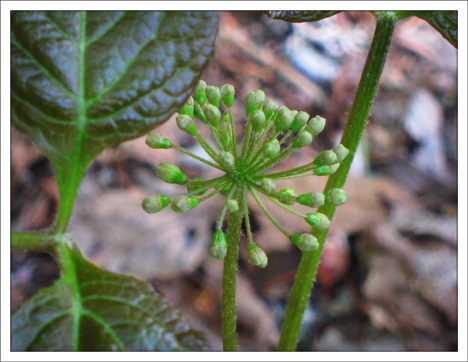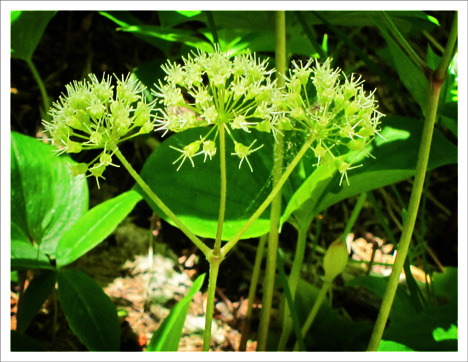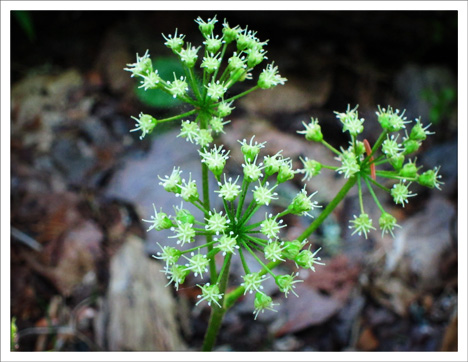Wild Sarsaparilla
Aralia nudicaulis

Wild
Sarsaparilla (also known as False Sarsaparilla,Shot bush, Small
Spikenard, Wild Licorice, Rabbit Root) is a flowering plant of
northern and eastern North America. The species name, from the
Latin nudus (naked) and cauli (stalk), refers to the leafless
flower stalk. The plant reaches a height of 12–24 inches,
with creeping underground stems. The single leaf stalk is divided
into three parts, each with five oval leaflets. The leaves are
finely toothed. Wild Sarsaparilla often grows in colonies from
creeping underground stems.
In
spring, the plant produces tiny greenish white flowers, usually
in three globe-shaped clusters 1.6 to 2.0 inches wide. The flowers
are hermaphrodite (have both male and female organs) and are pollinated
by bees. The flowers later develop into purple-black berries,
which are said to taste a little spicy and sweet. The seeds ripen
from August to September.
This
plant is very common in moist to dry woods throughout the north
woods region, especially in lightly shaded open woods. Its range
includes non-arctic Canada and northern and eastern US (south
to Georgia in the east and west to Colorado and Washington).

The
rootstock is said to be used as a favoring. It is a substitute
for sarsaparilla and is also used for making 'root beer'. The
plant was reportedly used by the Indians during wars or when they
were hunting since it is very sustaining.
The plant
also has been used for medicinal purposes. The aromatic roots
were formerly thought to cure a variety of ailments. Wild Sarsaparilla
reportedly had a wide range of traditional uses amongst the North
American Indians and was at one time widely used as a substitute
for the tropical medicinal herb sarsaparilla.

Wild Sarsaparilla
may be seen at the Paul Smiths VIC along many of the trails. It
usually begins blooming in late May.
References:
- Lady Bird
Johnson Wildflower Center. Native
Plant Database.
- United
States Department of Agriculture. Plants
Database.
- Enature.
Wildflower
Field Guide.
- Plants
for a Future. Database.
- Anne McGrath.
Wildflowers of the Adirondacks (EarthWords, 2000), p.
10.
- Doug Ladd,
North Woods Wildflowers (Falcon Publishing, 2001), p.
158.
- William
K. Chapman, et al. WiIdflowers of New York in Color (Syracuse
University Press, 1998), pp. 118-119.
- Lawrence
Newcomb, Newcomb's Wildflower Guide (Little Brown and
Company, 1977), pp. 182-1833.
|

